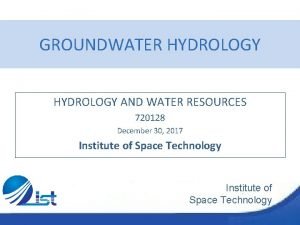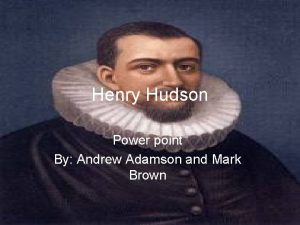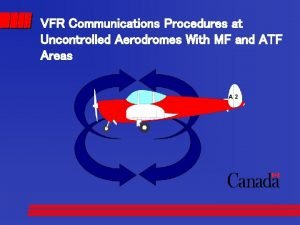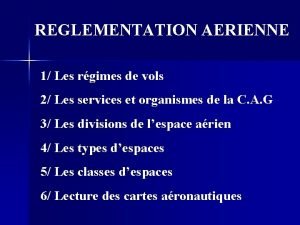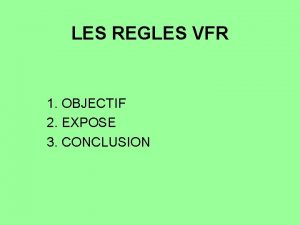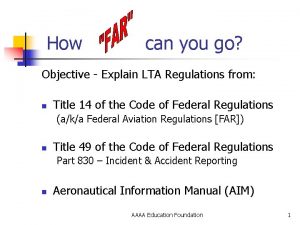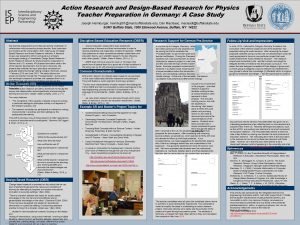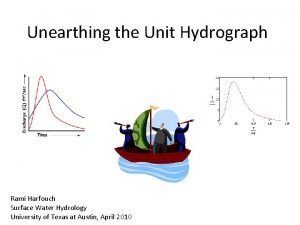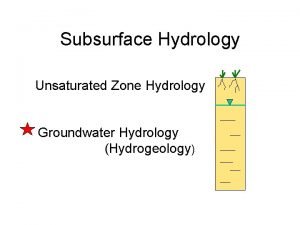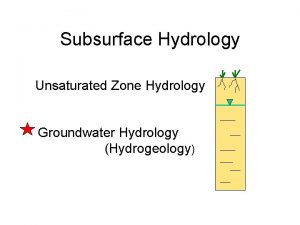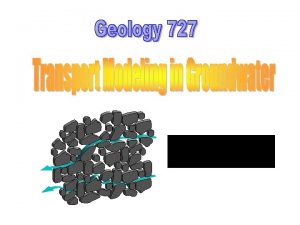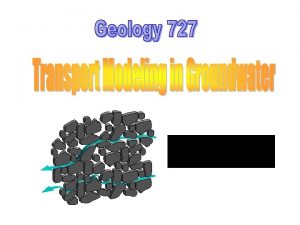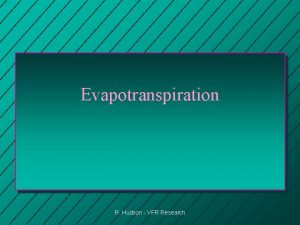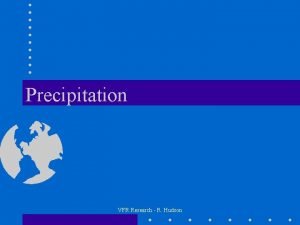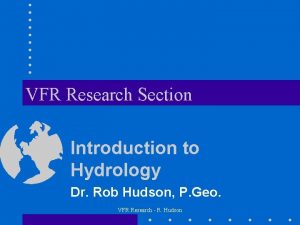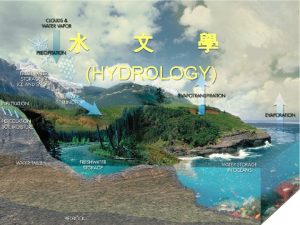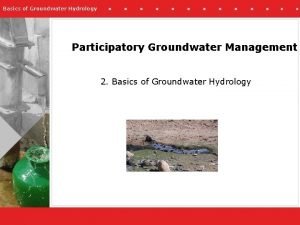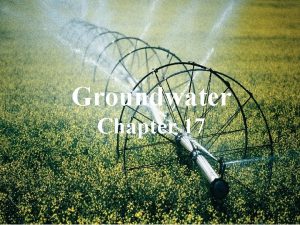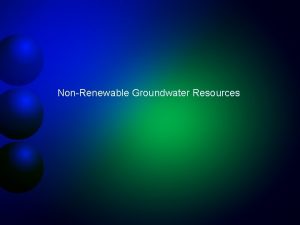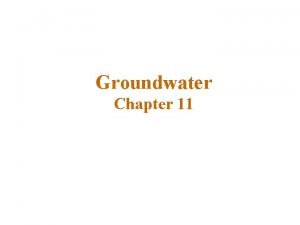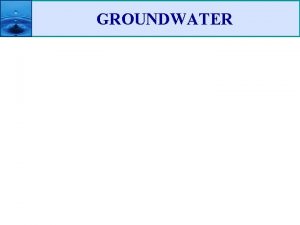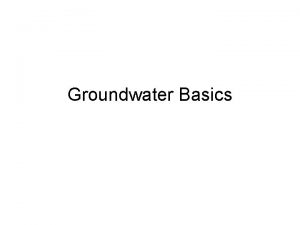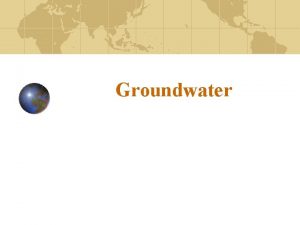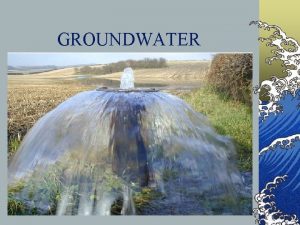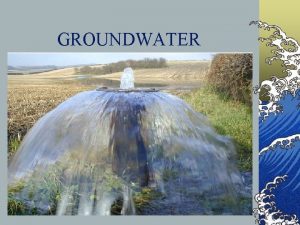Hydrology Groundwater R Hudson VFR Research Groundwater Topics


































- Slides: 34

Hydrology Groundwater R. Hudson - VFR Research

Groundwater Topics. . . • General principles – Hydraulic head, fluid potential – Darcy’s Law, saturated groundwater flow • • • Hydraulic conductivity K measurement of K porosity effects of heterogeneity on flow groundwater flow patterns on a slope R. Hudson - VFR Research

… relevant to Forest Hydrology – Unsaturated groundwater flow • hydraulic properties of unsaturated soil • drainage and infiltration – Interflow • Groundwater in relation to Forest Hydrology – How does forest harvesting affect groundwater – significance of those effects R. Hudson - VFR Research

Hydraulic head • Groundwater flows along an energy gradient – there are two possible energy gradients that affect groundwater flow: gravity and fluid pressure z = z 1 p 2 flow under fluid pressure z = z 2 gradient where p 1 > p 2 gravity drainage R. Hudson - VFR Research

Groundwater head - energy for flow Groundwater head is measured using a piezometer. z = elevation head above reference elevation (datum) Y = pressure head (m) Y z h=z+Y datum R. Hudson - VFR Research = P/rg where P = fluid pressure r = fluid density g = acceleration due to gravity

Water table well vs. piezometer R. Hudson - VFR Research

Darcy’s Law • Groundwater flow is a function of hydraulic head gradient – total flow Q has units of volume/time • typically m 3/s or litres/sec – specific discharge q is flow per unit area, units of length • the negative sign indicates that flow moves in the direction of falling head R. Hudson - VFR Research

Hydraulic conductivity K • groundwater flow is driven by the hydraulic gradient dh/dl • K is a measure of the resistance to flow, is a property of the porous medium and the fluid • K has units of m/s or cm/s • k is permeability, is a property of the medium related to diameter, packing, shape and roughness of grains (m 2, cm 2) • m is the viscosity of the fluid (kg/m. s) R. Hudson - VFR Research

Range of values of K R. Hudson - VFR Research

Porosity • Porosity is another important property of porous media that governs water flow – porosity is a measure of the capacity of the medium to hold water – a volume VT of soil of rock is divided up into the volume of voids Vv and volume of solids Vs – porosity n = Vv / VT – void ratio e = Vv / Vs R. Hudson - VFR Research

Range of values of porosity R. Hudson - VFR Research

Relations between K and n • for soil , they are inversely proportional – for well sorted sediments, the finer grained they are, the lower K is and the higher n is – for poorly sorted sediments, smaller grains fill in voids between larger grains reducing K and n • for rock, K and n are related to structure – sedimentary rock, both n and K are less than that of parent sediments due to mineral deposition in voids R. Hudson - VFR Research

Relations between K and n. . . – metamorphic and igneous rock have very low primary porosity, but K and secondary porosity are related to fracture spacing • porosity affects velocity of flow: – the lower the porosity, the greater the flow velocity: v = q/n – flow velocity = specific discharge/porosity R. Hudson - VFR Research

Heterogeneity • Geologic formations are generally not homogeneous – in BC, most forested terrain is characterized by relatively thin (1 -2 metre) coarse grained soils over basal till or igneous/metamorphic bedrock – the contact between soil and basal layer involves a sharp discontinuity in K such that the till or bedrock interface forms an impermeable boundary R. Hudson - VFR Research

Flow in layered heterogeneity Flow lines are perpendicular to equipotentials sand increasing head clay Flow will tend to go along the zone of higher K, and across the zone of lower K. Thus preferential flow occurs in high K zones. R. Hudson - VFR Research

Flow in layered heterogeneity. . . – the grain size distribution of soil is generally not uniform, so there are variations in hydraulic conductivity • zones of relatively high K in soil become preferred flow paths - they carry more flow than zones of lower K • the distribution of K zones can be random, or K can decrease with depth in soil due to increasing clay content - the latter situation will result in more rapid groundwater flow as the water table rises R. Hudson - VFR Research

Effects of slope steepness on flow • Slope gradients affect both direction and rate of groundwater flow – flow perpendicular to equipotentials – approx. lateral for steep slopes dh/dl R. Hudson - VFR Research dh/dl

Groundwater flow on a slope R. Hudson - VFR Research

Groundwater Recharge Groundwater flow follows hydraulic gradient: total head decreases with depth, thus there is a downward component to the groundwater flow. This is groundwater recharge, and in the abcence of water input, the water table will fall.

Groundwater discharge At riparian sites, groundwater discharge often occurs. In this case, head increases with depth, resulting in an upward component to groundwater flow. In the example shown, under high flow conditions the water table rises to the surface near the stream, groundwater discharges out of the soil and enters the stream by overland flow.

Later that year. . . at the same site, under low flow conditions, the water table and the stream stage have dropped. Groundwater is still discharging to the stream channel, but not at the soil surface. Total head is now independent of depth within the soil. There is no longer an upward component to groundwater flow. Discharge to the channel is essentially horizontal.

Occurrence of groundwater • Saturated vs. unsaturated – Define q as water content of soil – Saturated: all the void spaces are filled with water: qs = n – Unsaturated: void spaces are only partially filled with water: q < n – K is reduced because cross sectional area for flow is less than saturated cross section: K is now a function of moisture content R. Hudson - VFR Research

Saturated vs. unsaturated flow below water table Saturated: void spaces filled with water: q = n, Y>0 above water table Unsaturated: voids partially occupied by air: q < n, Y < 0. K is reduced; K = K(Y) or K(q) R. Hudson - VFR Research

Soil drainage and infiltration • If pressure head increases with depth, then why does soil drain? – recall, there are two components of head: pressure head and gravity head – soil drains under gravity when elevation gradient (dz/dl) > pressure gradient (d. Y/dl) – drainage will continue until equilibrium is reached – equilibrium may never occur R. Hudson - VFR Research

Infiltration • Initially, moisture content at the surface is low, hence K is low • When water is supplied to a dry soil, initially the water is absorbed, raising the moisture content and hence increasing Y • this creates a head gradient that drives water down towards the water table. • water moves down under large head gradient at the wetting front , overcoming the fact that K is low for dry soil R. Hudson - VFR Research

Infiltration rates • Over time, infiltration rate will tend towards the saturated hydraulic conductivity of the soil • Initial infiltration rates for dry soil can be up to 5 times Ks for very dry soil • typical infiltration rates forest soil are in the range of 50 to 300 mm/hr depending on the soil and its moisture content R. Hudson - VFR Research

Macropore flow • It is generally accepted among forest hydrologists (if not hydrogeologists) that macropore flow is a significant component of runoff from forested catchments – Darcy’s Law does not describe macropore flow – difficulty is in defining a representative dimension for a macropore – macropores can form a large interconnected network R. Hudson - VFR Research

Macropore flow (interflow) – they are formed from the rotting out of dead tree roots, aminal burrows, cracks in soil resulting from blocky structure, etc. • how to define a representative dimension for such a feature? – subsurface flow through macropore networks is much faster than soil matrix flow – often called interflow – we still do not know how to describe it mathematically R. Hudson - VFR Research

Forest harvesting and groundwater • Forest harvesting alters groundwater levels (thus, groundwater flow) by altering the water balance – increase in water available for infiltration due to decreased interception, increased snowmelt – decrease in extraction of water from the soil due to decreased evapotranspiration • Related activities can also alter soil structure R. Hudson - VFR Research

Effects of ground skidding and roads – ground based yarding can result in soil compaction, thereby reducing infiltration capacities • exessive access roads • ground skidding – these effects would tend to result in increased runoff, hence reduced infiltration • Road cuts on steep terrain can interrupt subsurface flows R. Hudson - VFR Research

Effect of road cut on groundwater flow Before: groundwater flow on treed slope After: potentially increased flow, interception by road cut, conversion to ditch flow R. Hudson - VFR Research

– intercepted flows can either be routed to the stream channel thereby altering streamflow hydrograph, or can be routed back onto slope below the road by way of culverts or cross ditches – in many cases, poorly placed culverts and inadequate culvert density have resulted in concentration of ditch flows onto unstable slopes, resulting in landslides R. Hudson - VFR Research

Improper culvert placement A plan view schematic of a road cut showing water flow pattern hillside above road cut bank road surface Too few culverts and poor placement results in flow disruption

Landslides and pore pressure – Increased pore pressures at the failure plane of potential instability results in reduced frictional contact between soil grains – this results in a reduction in the forces that keep the soil on the hillside.
 بئر ارتوازي
بئر ارتوازي Henry hudson lifespan
Henry hudson lifespan Uncontrolled aerodrome procedures
Uncontrolled aerodrome procedures Which of the reporting stations have vfr weather?
Which of the reporting stations have vfr weather? Incerfa alerfa detresfa
Incerfa alerfa detresfa Vfr cloud clearances
Vfr cloud clearances Part 121 operations
Part 121 operations Exposé sur vol de nuit
Exposé sur vol de nuit Cross country nav log
Cross country nav log Basic vfr minimums
Basic vfr minimums Qne
Qne Vfr special
Vfr special Vfr communications for idiots
Vfr communications for idiots Vfr flight rules
Vfr flight rules Vfr let
Vfr let Geoportail oaci vfr
Geoportail oaci vfr Vertical
Vertical Scope of operation research
Scope of operation research Research topics with objectives
Research topics with objectives Research questions for global perspectives
Research questions for global perspectives Technology research topics
Technology research topics Experimental psychology research topics
Experimental psychology research topics Wireless communication research topics
Wireless communication research topics Efl research topics
Efl research topics Action research topics in physics
Action research topics in physics Mobile computing research topics
Mobile computing research topics Data warehouse research topics
Data warehouse research topics Phenomenology research topics
Phenomenology research topics Simple content analysis
Simple content analysis Presentation and analysis of data pob sba
Presentation and analysis of data pob sba Research topics for pob sba
Research topics for pob sba Non experimental research design
Non experimental research design Operations research
Operations research What is ethnography in research
What is ethnography in research Applied hydrology
Applied hydrology
